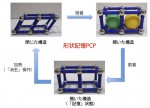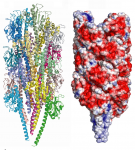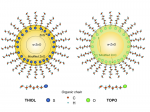Volume 18, No.3
August issue 2013
1. 最近の研究から/FROM LATEST RESEARCH
京都大学 物質-細胞統合システム拠点 Institute for Integrated Cell-Material Sciences, Kyoto University
- Abstract
- 有機物と無機物からなる「多孔性金属錯体」というナノ細孔をもつ結晶性の多孔性材料を用いて、分子の動きに由来する「サイズ効果」を世界で初めて発見した。具体的には、ゲスト分子を取り込む際にナノ細孔の構造を変化させるフレキシブル多孔性金属錯体に注目した。この化合物群は、分子を吸着する前はナノ細孔が閉じており、分子を吸着するとナノ細孔が開く。分子を取り除くとまた閉じた構造に戻る。この化合物の結晶サイズを数十ナノメートル(メゾスコピック領域)まで小さくすると、分子を吸着したナノ細孔が開いた構造から分子を取り除いても閉じた構造に戻らず、開いた構造を「記憶」していることがわかった。また開いた構造を加熱により閉じた構造へ戻すことにも成功した。分子の吸着情報をナノ細孔の構造により「記憶」し「消去」できる形状記憶ナノ細孔を合成することが可能になった。
[1]大阪大学大学院 薬学研究科 Department of Pharmaceutical Sciences, Osaka University、[2]大阪大学 微生物病研究所 Research Institute for Microbial Diseases, Osaka University
- Abstract
- 毒素原性大腸菌(ETEC)はその病原性を発揮するために、菌体表面上に線毛などを形成し、腸管上皮に定着する必要がある。CofAは、ETECの腸管への定着に関わるCFA/IIIと呼ばれる定着因子の主要線毛構成蛋白質である。本研究において、我々はSPring-8のビームラインBL38B1を使用した放射光実験を行い、蛋白質に内在する硫黄原子の異常分散効果を利用したS-SAD法を適用することで、CofAの結晶構造を0.9 Åの高分解能で解明した。さらに、結晶構造解析で得られたCofAの立体構造情報を基に、分子動力学シミュレーション法を用いてCFA/III線毛モデルの構築を行い、その特徴的な表面構造を明らかにした[1][1] Fukakusa, S., Kawahara, K., Nakamura, S., Iwashita, T., Baba, S. et al.: Structure of the CFA/III major Pilin subunit CofA from human enterotoxigenic Escherichia coli determined at 0.90 rsolution by sulfur-SAD phasing. Acta Cryst. D68 (2012) 1418-1429.。
[1]Instituto de Ciencia de Materiales de Aragón, CSIC-Un. Zaragoza, [2]Dpto. Física de Materiales, Un. Complutense de Madrid, [3]Instituto de Ciencia de Materiales de Madrid, CSIC, [4]Instituto de Cerámica y Vidrio, CSIC
- Abstract
- Discoveries of room-temperature ferromagnetism (RTFM) in diluted magnetic oxides and semiconductors hold great promise in future spintronics technologies. Unfortunately, this ferromagnetism remains poorly understood and the debate concerning the nature of ferromagnetism in semiconducting oxides is still open. Here, we demonstrate by using X-ray absorption (XAS) and X-ray magnetic circular dichroism (XMCD) the intrinsic occurrence of RTFM in these systems and point out that it is not related to the metallic cation but it relays on the conduction band of the semiconductor. We present here direct experimental evidence of the magnetic polarization of Zn atoms in ZnO nanoparticles capped with different organic molecules and on ZnS/ZnO heterostructures. The analysis of both XAS and XMCD spectra indicates the formation of a well defined interface between ZnO and the capping molecule in which the exotic magnetism resides. The occurrence of ferromagnetism does not critically depend on the details of the synthesis but on the formation of a pristine ZnS/ZnO interface. These results provide an avenue to explain the surprising results found in this field, sometimes seemingly irreconcilable, ending the longstanding controversy about the existence of intrinsic RTFM in ZnO-based systems. Moreover, they provide new insights to finally establish the mechanism that sets on the ferromagnetic order in these systems and bringing support to this new route for room-temperature semiconductor spintronics.
2. SACLA通信/SACLA COMMUNICATIONS
(独)理化学研究所 放射光科学総合研究センター XFEL 研究開発部門 XFEL Research and Development Division, RIKEN
3. 研究会等報告/WORKSHOP AND COMMITTEE REPORT
SPring-8 夏の学校実行委員会 委員長/(公財)高輝度光科学研究センター 利用研究促進部門 Research & Utilization Division, JASRI
4. SPring-8通信/SPring-8 COMMUNICATIONS
5. 談話室・ユーザー便り/USER LOUNGE・LETTERS FROM SPring-8 USERS
[1]SPring-8 ユーザー協同体(SPRUC) 会長/東京大学大学院 新領域創成科学研究科 Graduate School of Frontier Sciences, The University of Tokyo、[2]SPRUC 庶務幹事・放射光科学将来ビジョン作業部会担当幹事/(独)理化学研究所 放射光科学総合研究センター RIKEN SPring-8 Center














